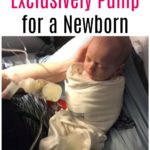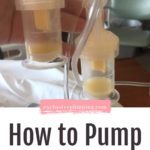Are you brand new at exclusively pumping, and not sure what exactly you should be doing? Here are some common questions about exclusively pumping for a newborn baby, including how often to pump, how long your pumping sessions should be, when you should be pumping, and how to make exclusive pumping easier.
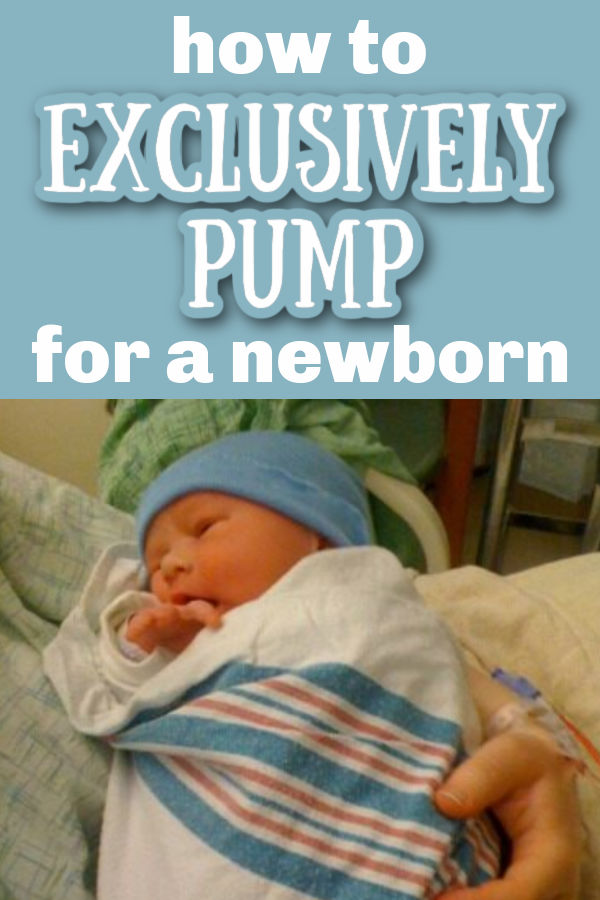
This post may contain affiliate links, which means that if you click a link and take action, I may make a small commission at no additional cost to you. I only recommend products I love! More info here.
When I started exclusively pumping, I had no idea what I was doing.
For example, I didn’t know that you were supposed to take the pump parts apart to wash them. I had no idea why my breasts dribbled milk sometimes and sprayed milk sometimes. And I wasn’t sure what speed I was supposed to set my pump to.
Here are the basics that I learned over time about how to exclusively pump with a newborn baby to build and maintain a milk supply, so you don’t have to bumble through it like I did!
How often should I pump when exclusively pumping for a newborn?
It’s important to pump frequently when your baby is a newborn in order to establish and maintain your milk supply.
Generally, in the first few months, I would recommend aiming for somewhere 7 to 10 pumping sessions per day.
How many sessions that you want to do within that guideline depends on your particular circumstances. For example, if you find you’re not pumping as much as your baby takes, you might want to be on the higher end of 9-10 sessions per day. However, if you have twins or older children and are completely overwhelmed, 7 might be what you can manage.
As your baby gets older, you can drop pumping sessions and pump less frequently.
How long should I pump for?
If you are exclusively pumping, you should be pumping for two hours or 120 minutes per day as a minimum guideline. (Much more on this guideline here.)
So, to determine how long you should be pumping for during each pumping session, divide 120 by the number of times that you’re pumping and set that as your goal. For example, if you’re pumping 8 times per day, you should pump for 15 minutes at a time.
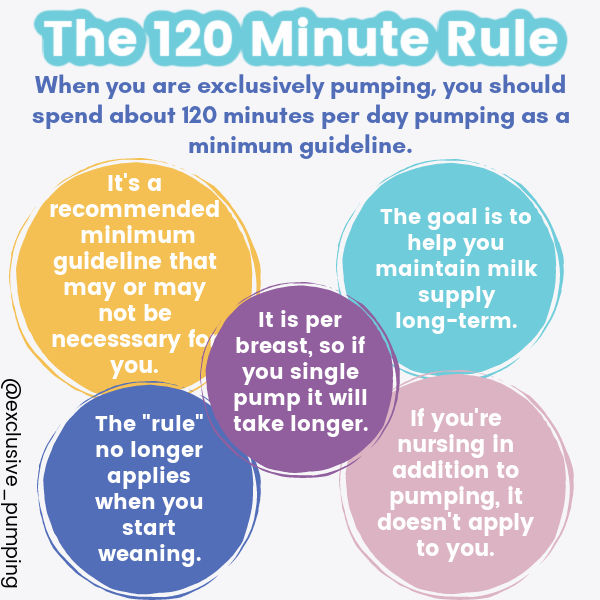
(It’s okay to pump for more than 120 minutes, too. You might just want to make sure you’re not getting burned out.)
You should pump for your full pumping time even if milk stops flowing, for two reasons:
- Your milk might let down again, allowing you to pump more milk. (Here is a full explanation of letdowns and how they work.)
- The nipple stimulation may help protect your milk supply long-term.
Tip: If your pump doesn’t have a timer on it, set one on your phone so that you can see how long you’ve been pumping and how much more time you have to go. It’s easy to forget when you started pumping or overestimate how long you’ve been hooked up to the pump.
When should I pump?
There are a few different ways to manage when you should pump:
- Pump whenever baby eats
- Pump on a schedule, at designated times every day
There are advantages to both methods. Pumping on a schedule means that you know when you’ll need to pump and can plan accordingly.
On the other hand, pumping when your baby eats is an easy way to ensure that you are pumping frequently enough, as it mimics nursing. It also gives you blocks of time in between pumping and feeding where you can get out of the house, sleep, etc.
When my son was a newborn, I pumped whenever he ate – my routine was to bottle feed him, change him, and then lay him down on my lap while I pumped. He would fall asleep, and then I would transfer him to his bassinet once I unhooked. Later, when life became more predictable, I switched to a more consistent pumping schedule.
(If you want help figuring out you schedule, I have a workbook that walks you through it step by step. Use EPUMP30 for 30% off.)
Do you need to pump at night?
If you can manage pumping at night, I would recommend it for the first three months or so, until your supply regulates.
This is both because frequent milk removal is important for establishing supply, and because many people tend to have a high output at this time. (This may be due to higher prolactin levels at night.)
How much much milk should I be producing?
Ideally, at each pumping session, you would get enough (plus maybe a little more!) for baby’s next feeding. However, it sometimes doesn’t work out that way. The amount that exclusive pumpers produce can vary quite a bit – some people will get 4 oz for their newborns, and others will get a few drops.
However much milk you pump, you are doing a great job.
How much breast milk will my baby need?
On average, most newborns will drink 1.5-3oz per feeding, or 20-25 ounces per day.
I did a survey on this topic a few years ago, and you can read more about the results here. The average for 0-1 month olds was 22.3oz; 1-2 month olds averaged 26.3oz.
(My son was huge and was up to 30oz by one month of age, so this can also vary quite a bit.)
If you don’t make enough breast milk and find that you need to supplement with formula, here are some tips for doing this.
What settings should I set my pump to?
Pumping settings can be a little confusing. There are usually three different things to pay attention to:
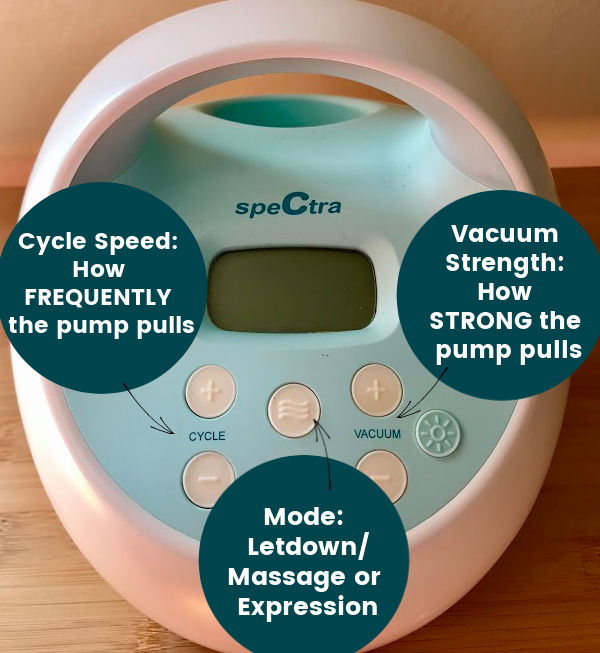
Most breast pumps have two modes – letdown/massage mode (light and fast) and expression mode (higher suction and slower). Many breast pumps automatically switch from letdown mode to expression mode after a minute or two.
When you’re pumping, you should set your vacuum strength to the highest speed that is comfortable. Slowly move it up to a higher suction until you start to feel discomfort, and then dial it back one setting. That’s the perfect suction for you.
There’s no “correct” setting to use for cycle speed, and some pumps (such as Medela pumps) don’t even have that setting. It’s best to just experiment and see what works best for you.
Much more on breast pump settings here.
How can I make this easier?
I think there are a few things that make exclusively pumping more manageable:
- Routines/systems. For everything related to pumping – pumping, feeding, washing bottles and pump parts, freezing extra milk – figure out a schedule or system for managing it so you don’t have to think about it.
- Help. If you have a partner or family member that can help, ask for help. Remember, you’re making the baby’s dinner every night, there’s no reason that others can’t help with the dishes.
- Products. There are a few products that can really make things easier, such as a hands-free pumping bra, extra pump parts, etc. Here are some things you may want to consider.
More on making exclusive pumping easier here.
I’m struggling with the emotional aspect of exclusive pumping. What can I do?
This can be really hard – it’s a loss, and it’s okay to grieve it. I did a short IGTV about coming to terms with this grief that might be helpful for you – you can watch it here.
Do you have any questions on exclusively pumping for a newborn? Ask them in the comments!
Want help putting together the perfect pumping schedule for you that saves your sanity AND your milk supply? Check out the Exclusive Pumping Playbook! Includes cheat sheets for setting up systems and routines to make things easier. Use EPUMP30 for 30% off.















